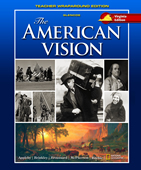The American Vision © 2011 Virginia EditionUnit 6:
Boom and Bust, 1920-1941Historical Thinking ActivitiesAssignment: Debating the Issues of the 1920s
Many Americans embraced the changes of the 1920s as welcome progress. Others believed the nation was abandoning its principles and traditions. Among the hotly debated issues were evolution, immigration, the "new woman," and prohibition. Select an issue, find someone to take the opposing side of the issue, and prepare to debate it in front of your classmates. Assignment Task List
Step 1: Review how to analyze information. See "Analyzing information" on page R7 of the Skills Handbook in The American Vision. Step 2: Read primary and secondary sources related to each of these issues. Select two or more of the sources to use as source material to prepare for your debate. Creationism versus Evolution:
Clash of Cultures: The Scopes Trial
NPR: Scopes Trial 75th Anniversary
PBS: Monkey Trial Immigration
Clash of Cultures: Immigration Restriction and the Ku Klux Klan Isolationism and Foreign Policy in the Interwar Years
The Washington Naval Conference
The Kellogg-Briand Pact The New Consumer Economy:
Prosperity and Thrift: The Coolidge Era and the Consumer Economy, 1921–1929 The "New Woman"
Clash of Cultures: The New Woman
The New Woman of the 1920s: Debating Bobbed Hair Prohibition
Clash of Cultures: Prohibition
The Volstead Act and Related Prohibition Documents Recommended Movies and Documentaries:
Inherit the Wind
Jazz: A Film by Ken Burns (PBS)
Monkey Trial (PBS) Recommended Books:
Frederick Lewis Allen, Only Yesterday: An Informal History of the Nineteen-Twenties
Linda Jacobs Altman, The Decade that Roared: America During Prohibition
Edward Caudill, Edward Larson, and Jesse Mayshark, The Scopes Trial: A Photographic History
Edward J. Larson, Summer for the Gods: The Scopes Trial and America's Continuing Debate Over Science and Religion Step 3: Create an outline of the information you have gathered. Step 4: Choose a side to debate. You must thoroughly research all aspects of the issue to support your argument and disprove your opponent's argument. Step 5: Prepare for the debate. You must write an opening statement, defining your position; a detailed outline of the major points that support your position; and a conclusion. Prepare notes that you will use for your presentation. You should understand both sides of the debate so you are prepared to counter your opponent's arguments. Step 6: Review your work against the checklist below. Revise your debate notes as needed. | A well-prepared debate will: | | • | have a clear thesis | | • | present ideas in a well-organized format with an introduction and conclusion | | • | describe the main ideas and clearly express your point of view to the audience | | • | analyze the other side's point of view to disprove the opponent's argument | | • | use correct spelling and grammar |
 | 

















